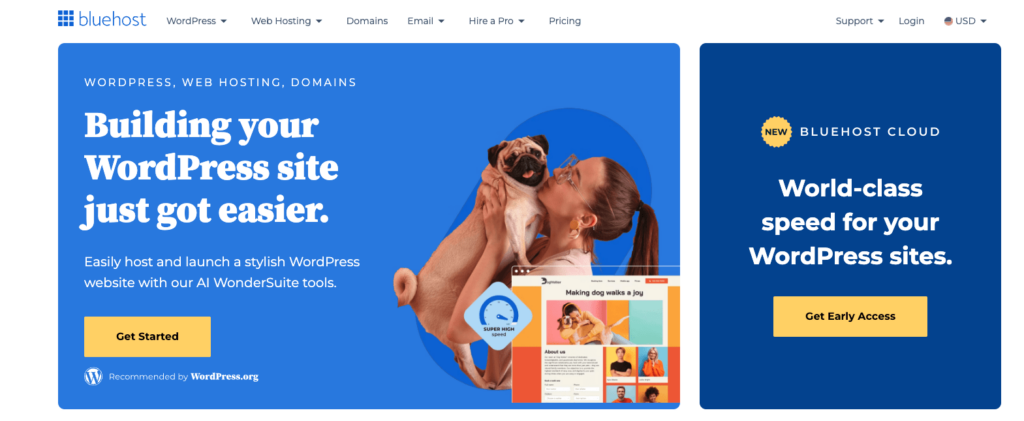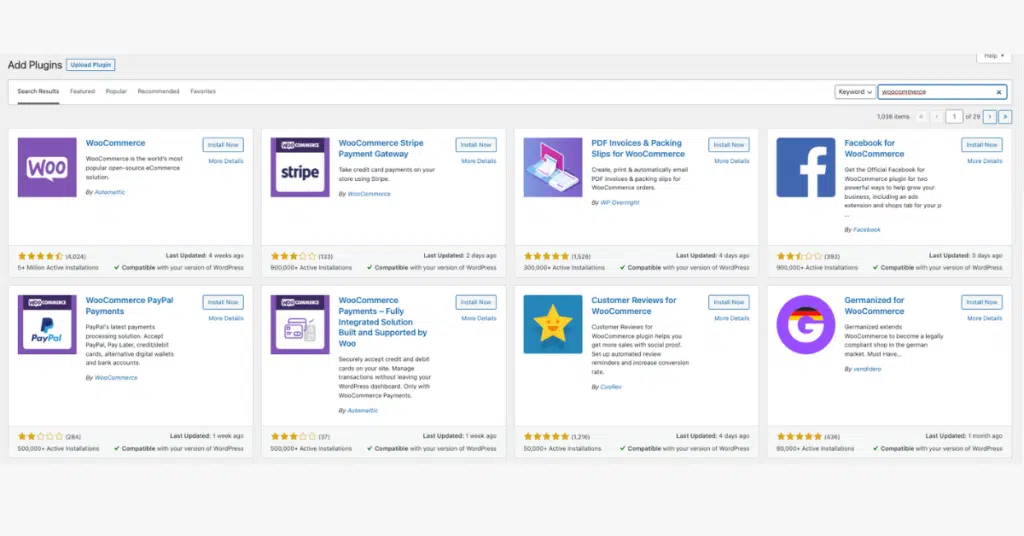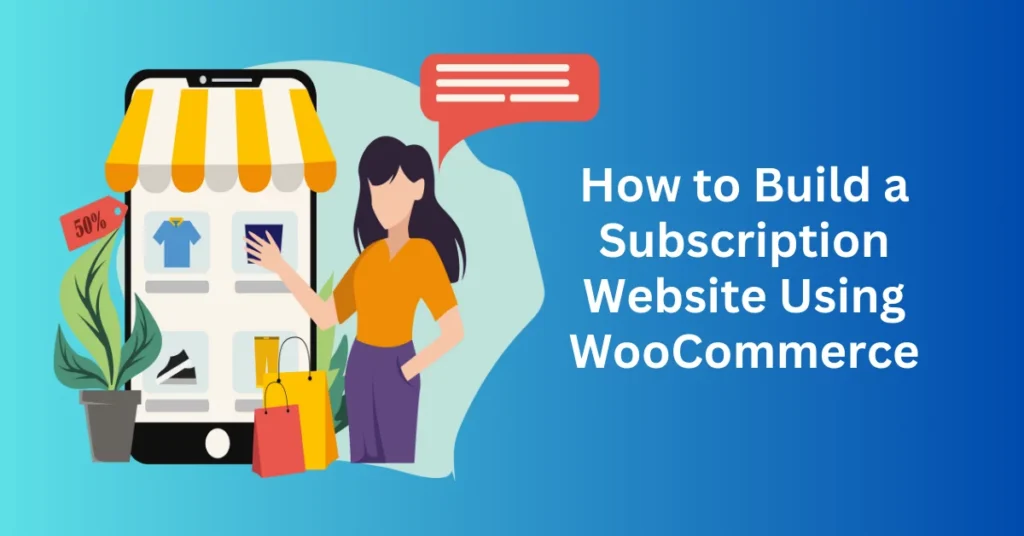Subscription website is rapidly becoming a go-to business model for entrepreneurs seeking to generate recurring revenue while building long-term customer relationships. Whether you’re offering digital memberships, subscription boxes, or exclusive content, these platforms provide a steady income stream and foster ongoing engagement with your audience.
When it comes to building a subscription website, WordPress and WooCommerce stand out as powerful and flexible solutions. Their wide range of features allows you to customize your site to suit your business needs. However, the process of setting up a subscription website can feel daunting, especially if you’re new to website creation.
This guide will show you how to launch, optimize, and grow your subscription business, making the process seamless and accessible for entrepreneurs at any level of expertise.
Why You Should Start a Subscription Business Website

Starting a subscription business offers numerous benefits, making it a smart choice for entrepreneurs seeking sustainable and scalable growth. Here are five key reasons why a subscription model could be ideal for your business:
1. Predictable, Recurring Revenue
Subscription businesses offer steady, predictable revenue streams through recurring payments, providing a solid foundation for financial stability. This consistency enables better cash flow management and more accurate forecasting, allowing you to plan effectively for long-term success. With customers’ ongoing commitments, subscription models reduce the reliance on one-time sales, ensuring a more reliable income and greater business growth potential over time.
2. Customer Retention and Lifetime Value
A subscription model fosters customer loyalty by focusing on long-term relationships. Subscribers are more likely to remain engaged over time, increasing their lifetime value (CLV). With the right value proposition, you can significantly reduce churn, enhancing profitability and ensuring continuous revenue from your existing customer base.
3. Scalability and Growth Potential
Subscription businesses can scale efficiently. With the right digital infrastructure, your business can grow without incurring significant additional costs. Digital subscriptions (such as online courses or software services) are particularly scalable, enabling you to expand your reach while maintaining low overhead.
4. Building a Loyal Community
Subscription models naturally encourage the formation of dedicated, engaged communities. As subscribers commit to ongoing relationships with your brand, they become advocates, offering valuable word-of-mouth marketing and enhancing customer loyalty. A strong community also provides ongoing feedback, ensuring your business remains aligned with customer needs.
5. Diverse Revenue Streams and Flexibility
The subscription model allows for diverse monetization strategies, such as tiered pricing, upselling, or offering exclusive content. You can adapt your offerings to meet different customer needs, maximizing revenue potential. This flexibility helps mitigate risk and opens up opportunities to cater to various segments of your audience.
Why a Website is Essential for Subscription Business
A website is the cornerstone of any successful subscription-based business, providing a centralized platform to attract, engage, and retain customers. For businesses offering recurring products or services, a professional website is essential. It not only streamlines business operations but also ensures the consistent delivery of value to subscribers. With 71% of businesses already utilizing a website, it’s clear that a strong online presence is critical for success in today’s competitive market. Therefore, if you’re planning to build a subscription site, selecting a reliable hosting platform is crucial to ensure smooth and efficient business operations.
Here’s why a website is essential for subscription businesses:
1. Centralized Operations
A website provides a central hub where you can efficiently manage all aspects of your subscription business. For example, you can seamlessly display subscription plans, handle customer payments, and manage user accounts in one place. Furthermore, platforms like WordPress and WooCommerce offer automation tools that streamline these processes, saving you valuable time while significantly reducing the risk of human error. As a result, this integration not only enhances operational efficiency but also boosts the accuracy of your transactions. Consequently, it creates a smoother experience for both your team and your customers.
2. Enhanced Customer Experience
Your website acts as the central point of interaction between your business and your subscribers. Moreover, a well-designed and user-friendly website ensures that customers can effortlessly browse available plans, register, and manage their accounts without any hassle. When the user experience is seamless, subscribers are more likely to remain loyal to your brand. In turn, this positive and frictionless experience not only increases customer satisfaction but also fosters long-term relationships—both of which are critical for the success of subscription-based businesses.
3. Scalability and Growth
As your subscription business grows, the need to expand your reach becomes increasingly important. A website enables you to scale by attracting a broader audience, extending your reach well beyond your immediate geographic location. By implementing effective SEO strategies, you can drive organic traffic to your site and convert casual visitors into loyal, paying subscribers. Moreover, with the flexibility to adjust your content and marketing efforts at scale, a website provides your business with the essential tools to foster sustainable growth and continuously engage a growing customer base.
4. Professional Credibility
In today’s digital-first world, having a website is essential for establishing your brand’s professional credibility. In fact, subscribers are far more likely to trust a business with a polished and well-maintained online presence. A well-crafted website not only showcases your commitment to quality and professionalism but also reassures customers that their subscription is in reliable hands. Additionally, by using platforms like WordPress and WooCommerce, you can effortlessly create a subscription site that aligns with your brand identity. This ensures a seamless and professional experience that leaves a lasting positive impression on your customers.
5. Efficient Subscription Management
A subscription website enables you to efficiently track and manage customer subscriptions, renewals, and payments. Furthermore, with the right platform in place, you can streamline these processes by automating billing cycles, sending timely reminder notifications, and offering flexible payment options. As a result, these features not only enhance customer satisfaction but also significantly reduce administrative overhead. Consequently, this allows you to shift your focus toward growing your business and driving long-term success.
Step-by-Step Guide: How to Build a Subscription Website
Building a successful subscription business requires careful planning, the right tools, and a solid website foundation. Here’s a comprehensive step-by-step guide to help you create and launch your subscription-based business:
Step 1: Define Your Subscription Website Goals and Purpose
Before diving into the technical details, it’s crucial to clearly define your subscription business goals. Establishing these goals will provide a roadmap for your website’s design and functionality.
Key Questions to Ask:
- What subscription model will you offer? Decide whether your business will focus on digital products (e.g., online courses, software), physical goods (e.g., subscription boxes), or services (e.g., memberships, ongoing consulting).
- Who is your target audience? Identify your ideal customers and understand their preferences, pain points, and motivations. This will guide your content, offers, and user experience design.
- What sets you apart? Understand your unique value proposition—what makes your subscription service stand out in the market?
- What are your long-term objectives? Consider how you plan to scale your business and the future features or services you may want to add. This ensures your website is built to grow with your business.
By answering these questions, you’ll be able to create a clear, targeted website that supports your specific needs. Whether you’re creating a membership site with exclusive content or a subscription box service that highlights products and recurring billing, setting goals will ensure your site aligns with your business objectives and customer expectations.
Step 2: Choose a Reliable Hosting Provider for Your Subscription Website
Your website’s performance is critical to your subscription business’s success. A reliable hosting provider ensures fast load times, high uptime, and overall website stability—important for maintaining a seamless user experience.
Why Bluehost is a Perfect Choice:
- Reliability and Uptime: Bluehost guarantees 99.9% uptime, ensuring your subscription site remains available to customers without interruptions.
- Scalable Plans: As your subscription business grows, Bluehost offers flexible hosting plans that scale with your needs.
- Free Domain Name for the First Year: Bluehost includes a free domain for the first year, helping you establish a professional and memorable online presence from the start.

A well-chosen domain name is just as important as your hosting. Select a domain that’s short, memorable, and closely tied to your business, as it plays a key role in brand recognition and online visibility.
With Bluehost, you can rest assured that your subscription website will have a solid foundation, equipped with a reliable hosting platform and a domain name that sets the stage for success.
Step 3: Install WordPress for Your Subscription Website
Setting up WordPress with Bluehost is simple and fast. Bluehost’s streamlined process allows you to get your site up and running without any technical headaches.
Getting Started with Bluehost:
- Sign Up for a Hosting Plan: Choose a WordPress hosting plan that fits your subscription business needs. Bluehost offers both shared hosting and managed WordPress hosting, which can grow with your business.
- Install WordPress: Once you’ve chosen a plan, Bluehost offers a one-click WordPress installation. This lets you easily access the WordPress dashboard where you can manage themes, plugins, and your content.
This process is designed to save you time and get your subscription site live quickly. Bluehost’s WordPress hosting ensures reliable performance, making it easier to focus on growing your business.
Step 4: Select a Subscription Website-Friendly Theme
The theme you choose plays a crucial role in the user experience and conversion rate of your subscription website. Look for a theme that is specifically tailored for subscription-based businesses.
Key Features to Look for:
- Subscription Functionality: Choose a theme that supports recurring billing and membership management. It should integrate seamlessly with WooCommerce to handle payments efficiently.
- Mobile-Responsive Design: With many users accessing websites on mobile devices, it’s essential to choose a theme that adapts well to different screen sizes.
- Clean, Professional Layout: A sleek, modern design builds trust with potential customers and helps guide them through the subscription process, from browsing to checkout.
A subscription-friendly theme ensures that your site is easy to navigate and optimized for conversions, providing a positive experience for visitors and potential subscribers.
Step 5: Install Essential Plugins for Subscription Website
Plugins are essential for enhancing your website’s functionality and providing a smooth, optimized user experience. WordPress offers a variety of plugins specifically designed to support subscription-based businesses.

Must-Have Plugins for Subscription Websites:
- WooCommerce: For handling subscriptions, recurring payments, and e-commerce functionality.
- MemberPress or Restrict Content Pro: For managing memberships, access control, and content protection.
- WPForms: For creating customizable subscription forms to capture leads and new subscribers.
- AffiliateWP: If you plan to run an affiliate program, this plugin helps you manage affiliates and track their commissions.
- SEO Plugins (Yoast SEO or RankMath): For optimizing your subscription site’s visibility on search engines.
Using the right plugins will streamline your business operations, automate key tasks, and provide a better experience for your subscribers, which is crucial for retention and growth.
Step 6: Create Engaging and Optimized Content
Creating engaging, informative, and optimized content is crucial for converting visitors into loyal subscribers. High-quality content not only drives traffic but also enhances user experience, builds trust, and supports SEO. Below are the key pages your subscription website should include, along with SEO strategies to boost visibility.
Essential Pages for Subscription Website
Home Page:
Your homepage serves as the first impression of your subscription service. It should immediately convey the value of subscribing to your service.
- What to Include:
- Subscription Plans & Benefits: Clearly highlight your subscription options and the unique benefits of each plan. Use concise copy to communicate the value and advantages.
- Unique Value Propositions: Explain what makes your service stand out from the competition—whether it’s exclusive content, premium customer support, or unique features.
- Clear CTAs: Place prominent calls to action (CTAs) that encourage visitors to sign up or learn more. Use action-driven language like “Join Now” or “Start Your Free Trial.”
- SEO Best Practices: Use relevant keywords such as “best subscription service,” “recurring billing plans,” and “exclusive membership” to help improve your site’s search engine ranking.
About Us Page:
The About Us page should tell your brand story, making an emotional connection with visitors.
- What to Include:
- Mission and Values: Share the story behind your subscription business and the purpose it serves. Explain why you started the service and how it benefits your customers.
- Personal and Authentic Tone: Use a friendly, conversational tone to make visitors feel more connected to your brand.
- Why Subscribe: Convince users why subscribing to your service will bring value to them.
- SEO Best Practices: Incorporate keywords related to your niche, such as “exclusive [industry] content” or “premium subscription services,” to improve local and global SEO.
Subscription Options:
Make it easy for visitors to understand your subscription plans and choose the one that best suits their needs.
- What to Include:
- Clear Descriptions & Pricing: Break down each plan’s features, benefits, and pricing in a visually appealing manner, making it easy to compare options.
- Subscription Functionality: Highlight features such as “recurring billing,” “exclusive content,” or “premium member benefits.”
- Simple Process: Make the subscription process clear and user-friendly, so potential customers can easily sign up without confusion.
- SEO Best Practices: Optimize this page with keywords such as “monthly subscription,” “best membership options,” and “recurring subscriptions.”
Testimonials:
Display customer reviews and testimonials to build credibility and trust with potential subscribers.
- What to Include:
- Variety of Reviews: Showcase testimonials from customers who’ve benefited from your service. Highlight different aspects, such as product quality, ease of use, customer service, and overall experience.
- Visual Appeal: Use customer photos or video testimonials to make the page more engaging and authentic.
- SEO Best Practices: Optimize the page with keywords like “customer reviews for [your service]” and “best subscription service testimonials.”
Blog Section:
A blog is a powerful tool to engage visitors, demonstrate expertise, and drive organic traffic.
- What to Include:
- Valuable Content: Publish articles that provide value to your target audience. This could include tips on how to make the most out of your subscription, industry updates, or case studies.
- SEO-Optimized Posts: Use your blog as an opportunity to incorporate keywords like “membership sites,” “subscription business tips,” or “exclusive content.”
- Regular Updates: Post regularly to keep your audience engaged and improve search engine rankings.
- SEO Best Practices: Include internal links to other pages on your site and external links to authoritative sources to enhance SEO.
Contact Page:
Your contact page should provide visitors with all the information they need to get in touch with you or find your physical location if relevant.
- What to Include:
- Essential Contact Information: Include an email address, phone number, and links to social media profiles.
- Google Map (for Local Businesses): If you have a physical location, embed a Google Map to improve local SEO and help users find you easily.
- User Registration Form: If applicable, include a form for users to register or request more information about your service.
- Payment Methods: Clearly list your available payment methods for subscribers, making it easy for users to choose their preferred option.
- SEO Best Practices: Use local SEO strategies, such as including location-based keywords and ensuring your contact details are consistent across directories.
Step 7: Optimize for Mobile and Ensure Fast Loading Times
Optimizing your subscription website for both mobile responsiveness and fast loading times is crucial to delivering an exceptional user experience. With the growing number of users accessing websites through mobile devices, having a responsive design is not just a convenience—it’s a necessity. A mobile-friendly website ensures smooth navigation across different screen sizes and devices, which is particularly important for subscription and membership-based sites where user engagement directly impacts retention and conversions.
Mobile Optimization
To make your website mobile-responsive, ensure that the theme you’re using is fully optimized for all device sizes, from desktops to smartphones and tablets. A mobile-friendly design automatically adjusts layout elements like text, images, and buttons to fit smaller screens without sacrificing functionality or aesthetics. Mobile optimization doesn’t just improve user experience, but it also encourages higher engagement, as users are more likely to stay on a site that’s easy to navigate on their mobile devices. With most visitors using smartphones, investing in mobile optimization significantly enhances user retention and satisfaction, two key factors for growing your membership base.
Speed Optimization
Website loading speed is a critical factor for both user experience and search engine rankings. Users expect websites to load quickly, and if a page takes too long, they are more likely to bounce, reducing your chances of converting them into paying subscribers. Slow loading times can also negatively impact SEO, as search engines like Google consider site speed when ranking pages. To ensure fast performance, use caching plugins such as W3 Total Cache to store static files and reduce server load, which leads to faster page loads. In addition, implement image compression tools like Smush to reduce file sizes without sacrificing image quality. These tools enhance load times, lower bounce rates, and increase conversion rates, making your site more efficient and user-friendly.
Image Optimization
Using tools like Smush or Imagify, you can automatically compress images while retaining high quality. This not only improves load speed but also helps maintain the visual integrity of your content, even with a large volume of images. A faster-loading site will ensure your users don’t experience frustration due to slow image-heavy pages, and it will lead to better overall performance.
Content Delivery Network (CDN)
A CDN caches your site’s content across multiple servers globally, so users from different regions can access the content from the server closest to them. This reduces load times and improves the site’s overall performance, especially for international visitors. By ensuring faster content delivery, CDNs contribute not only to a better user experience but also to higher search engine rankings, as Google favors fast-loading websites with global accessibility.
Step 8: Integrate Subscription and Payment Systems
To manage payments seamlessly and enhance user experience, integrating reliable subscription tools and payment gateways into your site is essential. Secure, user-friendly payment systems instill trust, encourage conversions, and help ensure long-term subscriber satisfaction.
Payment Gateways
Choose versatile and widely trusted payment gateways that cater to a variety of subscriber preferences. Popular options include:
- PayPal: A globally recognized platform offering secure, one-click payments.
- Stripe: Supports multiple payment methods, including credit cards, Apple Pay, and Google Pay, ensuring flexibility.
- Direct Credit Card Payments: Simplify transactions by enabling secure credit card processing directly on your site.
By integrating these gateways through tools like WooCommerce, you provide a smooth and trustworthy checkout experience for subscribers, increasing the likelihood of successful conversions.
WooCommerce Subscription Plugin
WooCommerce’s subscription plugin is a powerful tool for managing recurring payments and subscriber accounts. Key features include:
- Automated Billing: Streamlines monthly, annual, or custom subscription cycles without manual intervention.
- Free Trials and Discounts: Entice potential subscribers with introductory offers.
- Renewals and Cancellations: Simplify account management for subscribers, reducing frustration and improving retention.
This plugin helps you stay organized while delivering an effortless experience to your users.
Other Tools to Enhance Growth
Integrating affiliate marketing programs can help boost your subscriber base by leveraging partnerships:
- AffiliateWP: This tool works seamlessly with WooCommerce to create and manage affiliate programs. Reward affiliates for referrals, drive traffic, and track conversions effectively. It automates payouts and simplifies referral management, making it an excellent addition to your subscription site.
By offering affiliates incentives, you expand your reach while maintaining cost-effective marketing efforts.
Step 9: Test Your Site Before Launch
Before going live, thoroughly test your subscription website to ensure a seamless experience for users. Rigorous testing minimizes errors and guarantees that every aspect of the site functions as intended.
Key Areas to Test
Subscription Sign-Up and Payment Processes
Ensure that all sign-up forms, checkout pages, and payment gateways, such as PayPal and Stripe, function without issues. Testing should include completing transactions under different scenarios, such as signing up for free trials, making payments, or canceling subscriptions. Each process must work seamlessly to avoid disruptions that could deter potential subscribers and to provide a smooth user experience from start to finish.
Navigation and User Experience (UX)
Evaluate your website’s navigation to confirm it is intuitive and user-friendly. Users should be able to effortlessly find essential pages such as subscription plans, FAQs, and contact information. An accessible layout not only improves the overall experience but also helps guide visitors smoothly through the conversion funnel.
Mobile Responsiveness
Test your website on various devices, such as smartphones and tablets, to ensure it delivers a consistent and enjoyable experience across all screen sizes. Additionally, a responsive design should adapt seamlessly to smaller screens without compromising functionality or aesthetics. This ensures that mobile users can easily navigate and engage with your site, providing them with a positive experience no matter the device they use.
Speed and Loading Times
Use performance measurement tools, such as Google PageSpeed Insights or GTmetrix, to assess your site’s loading times. By identifying and addressing any slow-loading pages, you can enhance the user experience and prevent potential subscribers from leaving before completing their actions. Moreover, fast loading times are essential for maintaining user satisfaction and play a significant role in improving your site’s search engine rankings, ultimately helping you attract and retain more subscribers.
Email Notifications and Integrations
Verify that all automated email notifications, such as welcome messages, renewal reminders, and payment failure alerts, are sent correctly and on time. Additionally, test integrations with third-party tools like customer relationship management (CRM) software, analytics platforms, and marketing automation tools to ensure seamless data flow and operational efficiency.
How to Market Your Subscription Business Website

Effective marketing is essential for growing your subscription website, driving traffic, and converting visitors into loyal subscribers. Platforms like YouTube are especially beneficial for small businesses, allowing you to share compelling content that highlights the value of your services. By combining video marketing with other strategies like social media advertising, email campaigns, and search engine optimization (SEO), you can significantly boost your website’s visibility and attract a larger audience. Additionally, offering exclusive promotions or free trials is a proven way to encourage sign-ups and foster customer loyalty. Below are actionable techniques to effectively market your subscription website.
Social Media
Social media platforms are invaluable tools for promoting your subscription service and engaging with potential subscribers. Share a mix of content that resonates with your audience, such as behind-the-scenes glimpses of your business, customer success stories, and time-sensitive promotions. Platforms like Instagram, Facebook, and TikTok are particularly effective for increasing reach and building relationships with your audience. Create interactive posts such as polls, Q&A sessions, and contests to boost engagement. Utilize targeted ads on these platforms to reach users who are most likely to benefit from your subscription service.
Boost Visibility with SEO and PPC Campaigns
Optimizing your website for search engines is a long-term strategy to drive organic traffic. Focus on keyword-rich blog posts, optimized meta descriptions, and local SEO techniques to help potential subscribers find your website. In addition to SEO, running pay-per-click (PPC) campaigns through Google Ads or social media platforms can provide an immediate boost in visibility. With PPC, you can target specific demographics and interests, ensuring your marketing budget is spent efficiently to attract high-quality leads.
Foster Engagement with User Groups
Building a sense of community around your subscription service is a powerful way to encourage repeat visits and foster brand loyalty. One effective approach is to create user groups or forums where subscribers can connect, share experiences, and engage in meaningful discussions. These groups can also serve as a space to share exclusive content, offer sneak peeks of upcoming features, and gather valuable feedback. Platforms like Facebook Groups or a dedicated section on your website can act as central hubs for this interaction, enriching the subscription experience and adding even more value for your subscribers.
Drive Traffic with Sign-Up Fee Promotions
Promotional offers are a proven strategy for driving sign-ups and increasing traffic. For example, offering discounts on initial subscription fees or creating limited-time deals can incentivize new subscribers to join. Additionally, free trials or “first month free” offers are especially effective, as they give users the opportunity to experience your service without any risk. To maximize their impact, be sure to prominently highlight these promotions on your website and across your social media channels. This will generate buzz, create urgency, and encourage potential customers to take action.
Engage and Nurture with Email Marketing
Email marketing remains one of the most cost-effective tools for nurturing relationships and driving conversions. To start, build an email list by offering lead magnets—such as free resources or exclusive content—in exchange for sign-ups. Once you’ve established your list, send regular newsletters that feature updates, promotions, and valuable insights to keep your audience informed and engaged. Additionally, use email campaigns to share exclusive discounts or notify subscribers about new features and services. By doing so, you ensure that your subscribers feel valued, stay connected to your brand, and are more likely to convert into long-term customers.
Utilize Video Marketing
Video content is a dynamic and engaging way to showcase your subscription website’s value proposition. Platforms like YouTube offer the perfect opportunity to create tutorials, explainer videos, or customer testimonials that highlight the benefits of your service. Additionally, live videos or webinars provide another excellent way to engage your audience in real time, answering their questions and building a stronger connection with your brand. These interactive sessions help establish trust and authority, positioning you as a credible leader in your niche while keeping your audience informed and engaged.
By implementing these strategies, you can effectively market your subscription website, attract a larger audience, and cultivate long-term subscriber loyalty. A multi-channel approach that combines SEO, social media, email marketing, and promotions ensures maximum reach and engagement, helping your business thrive in a competitive market.
Final Thoughts: How to Build a Subscription Business Site Using WooCommerce
Building a subscription site using WordPress and WooCommerce is easier than you might think. By following the steps in this guide—from setting up your site and integrating essential plugins to optimizing for performance and user experience—you can create a platform ready to generate recurring revenue and foster lasting customer loyalty.
Take the first step toward launching your WordPress membership site today with Bluehost, a trusted hosting provider designed to support your goals. With the right tools and strategies, you can turn your subscription idea into a thriving business. Ready to get started? Visit Bluehost and set the foundation for your subscription site’s success!


